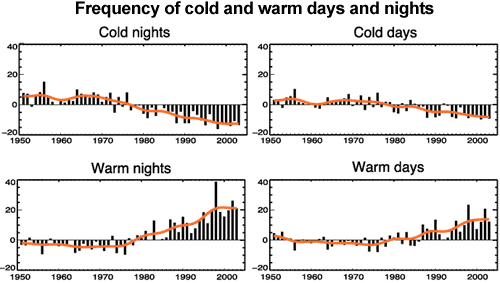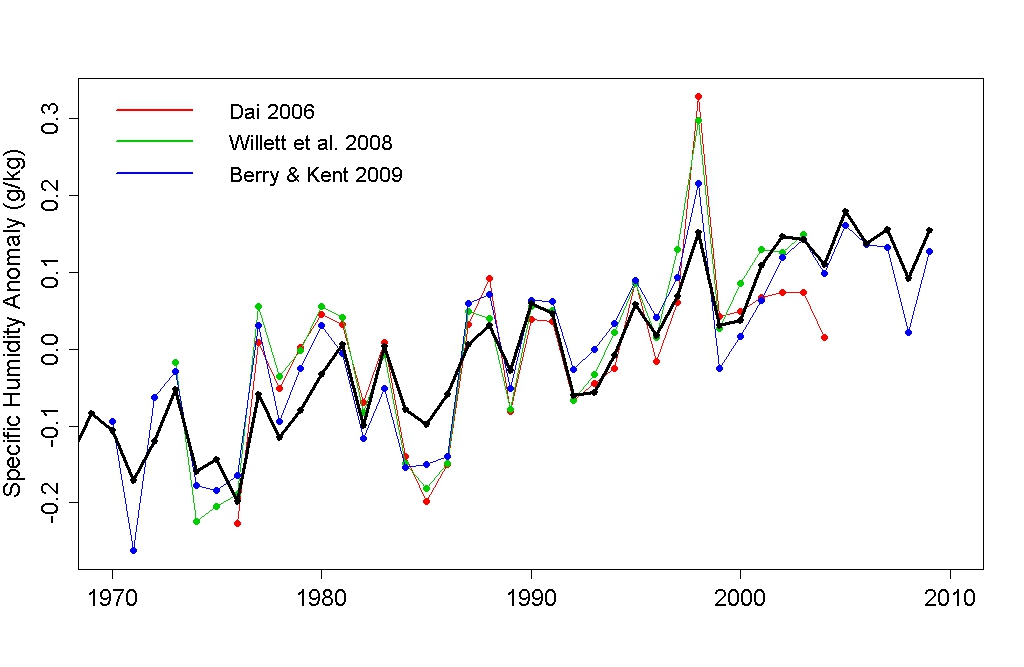The human fingerprint in the daily cycle
Posted on 20 November 2010 by John Cook
During the day, the sun warms the Earth's surface. At nighttime, the surface cools by radiating its heat out to space. Greenhouse gases slow down this cooling process. This is why deserts cool so much at night. Water vapour is a strong greenhouse gas and the dry desert air traps much less heat than more humid areas.
A more extreme example is the moon which has no atmosphere. At nighttime, there are no greenhouse gases to trap the outgoing heat. Consequently, the difference between day and night is more extreme with daytime temperatures getting up to around 118°C and nighttime temperatures falling below -168°C. In other words, the stronger the greenhouse effect, the smaller the difference between daytime and nighttime temperatures.
We are currently experiencing global warming. If an increased greenhouse effect is a significant part of this warming, we would expect to see nights warming faster than days. There have been a number of studies into this effect, which confirm that this is indeed the case. One study looked at extreme temperatures in night and day. They observed the number of cold nights was decreasing faster than the number of cold days. Similarly, the number of warm nights was increasing faster than the increase in warm days (Alexander 2006).

Figure 1: Observed trends (days per decade) for 1951 to 2003 in the number of extreme cold and warm days and nights per year. Cold is defined as the bottom 10%. Warm is defined as the top 10%. Orange lines show decadal trend (IPCC AR4 FAQ 3.3 adapted from Alexander 2006).
The difference between daytime and nighttime temperatures is also known as the diurnal temperature range (DTR – the difference between minimum and maximum daily temperature). An increased greenhouse effect should cause the DTR to decrease. Over the last 50 years, DTR over land has shown a large negative trend of ~0.4°C (Braganza et al. 2004). The reason for the falling DTR is because nighttimes have been rising faster than daytime.
The daily cycle also offers interesting insights into climate change over the 20th Century. From the 1950s to early 1980s, global temperatures cooled slightly. A large contributor to the cooling was "global dimming" from 1958 to 1990 where less sunlight made it to the Earth's surface due to air pollution. However, over this period, the nighttime minimum temperature increased. While global dimming was cooling daytime temperatures, the increased greenhouse effect was warming the nights (Wild et al 2007). Even during mid-20th Century cooling, greenhouse warming was percolating away while we were sleeping.































 Arguments
Arguments























 0
0  0
0 I'm suggesting that the interpretation of this data goes way beyond what the actual data is telling us.
I'm suggesting that the interpretation of this data goes way beyond what the actual data is telling us.







Comments